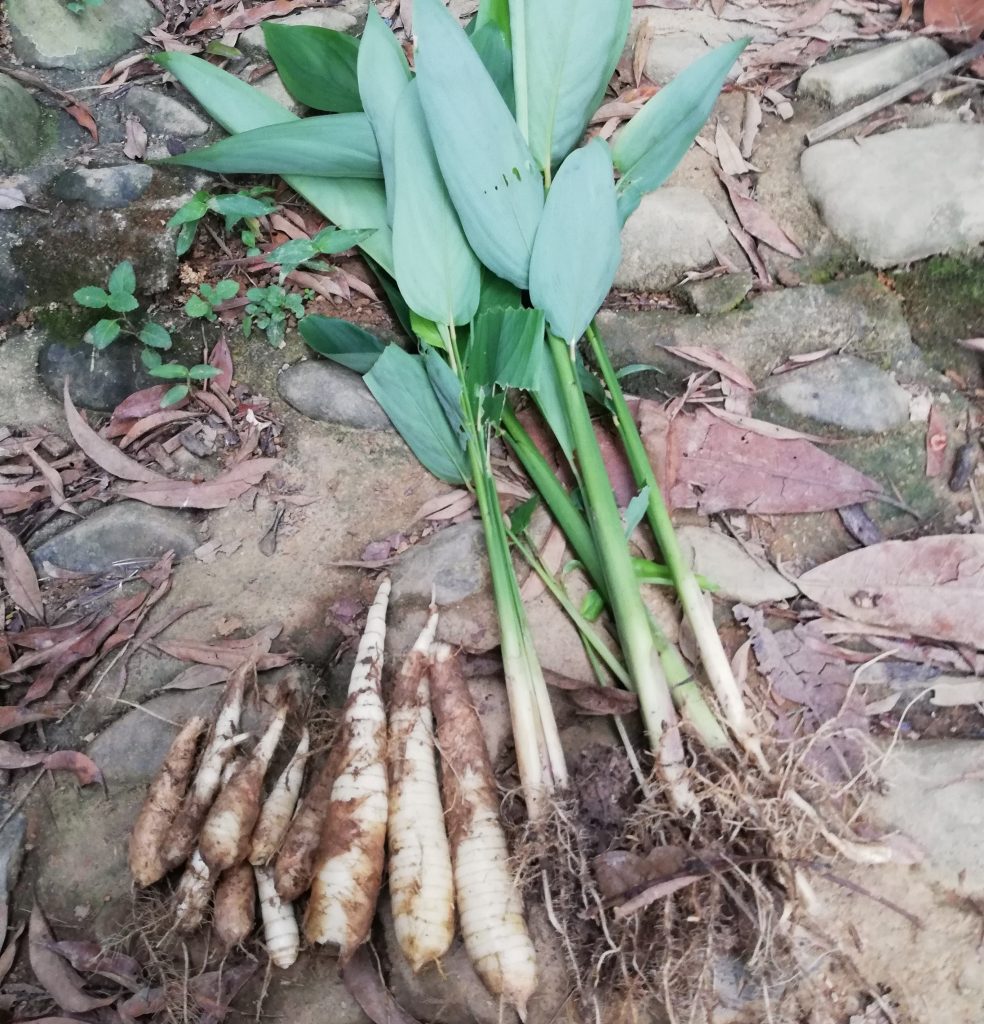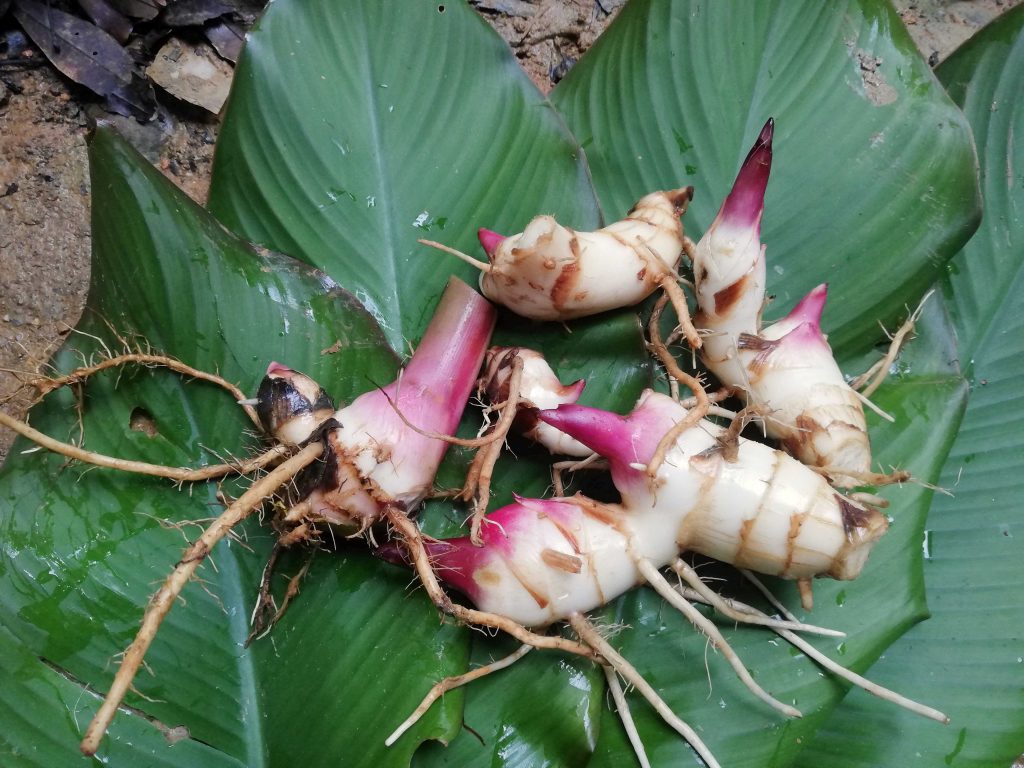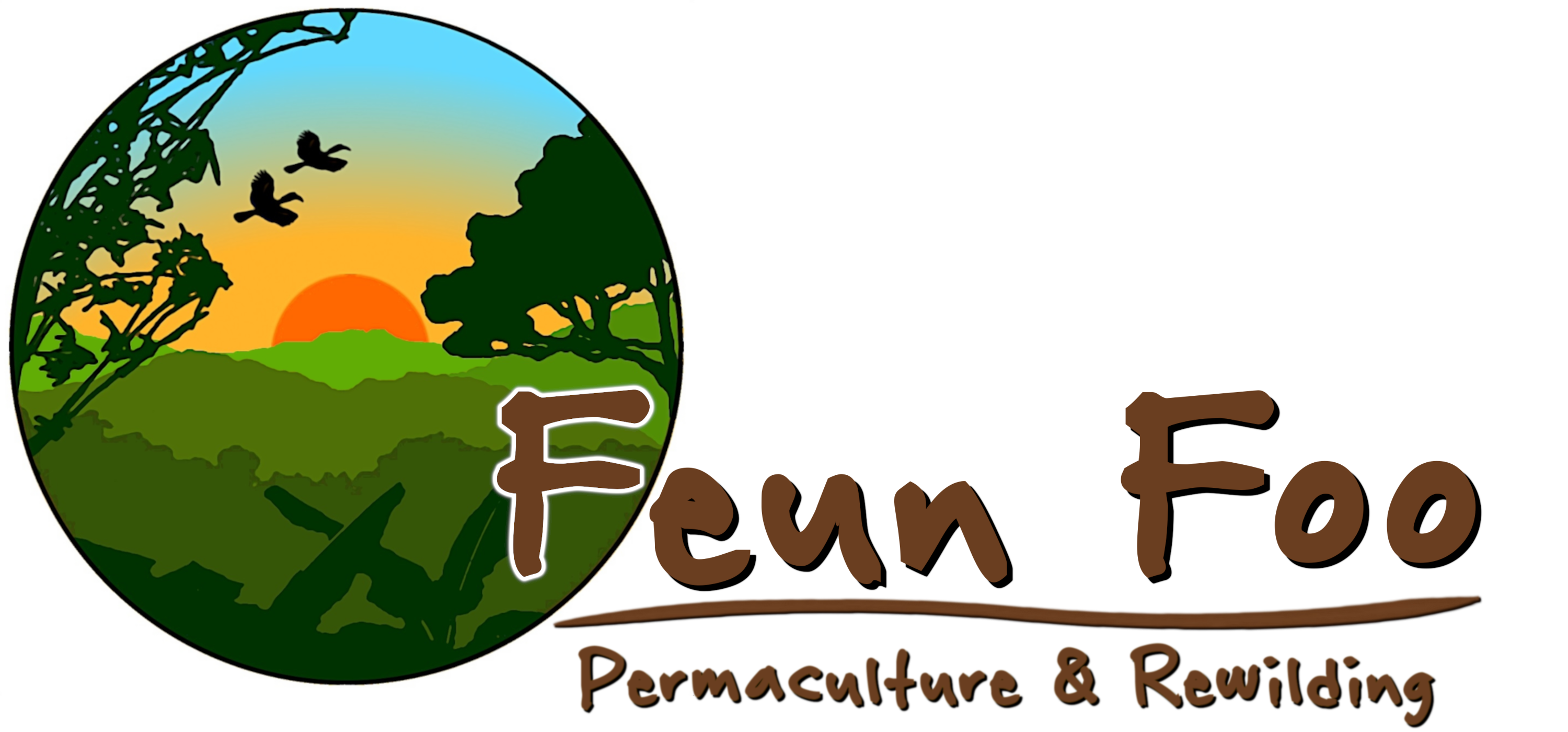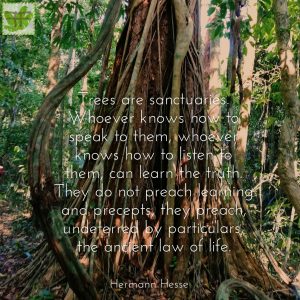
What to Eat when the Stores are Empty
Simple, Localized Approaches to Food Systems Resilience and Food Security in Southeast Asia
Please note: This article is part of an ongoing series in which we explore possible solutions to our current predicament. Click here to read the previous chapter Part Two: Staple food diversification – Jackfruit and Artocarpus spp.
To read the abstract on the index page, click here.
Part Three: Staple food diversification – Cassava, Yams and various Wild Tubers
In Part Three of this series, we will explore another class of important staple foods: the various starchy roots and tubers, both native and imported from tropical countries around the world, that grow so easily in this climate. Again, this is nothing new, but actually just a readaptation of techniques that traditional societies have used for millennia. Ever since the first humans arrived in Southeast Asia, starchy root crops were a regular part of their diet, since there are already many species of wild Yams growing in any jungle environment. Further diversification happened when international trade brought new crops from the Americas, many of which instantly thrived in Southeast Asia. All of those tubers are extremely hardy, some are very drought-tolerant (especially species native to the Northeast of Thailand), and others have no problem with very wet conditions or even flooding (such as most species of Yams, Cassava, and especially Taro). Some grow quite large, and can reach a weight of several kilos, especially if harvested more than a year after planting. A combination of several species of Yams, Cassava, and Jackfruit (or other Artocarpus spp., see Part Two) can easily be enough to satisfy the dietary requirement for carbohydrates. But before we get to those undisputed champions of future food security, it’s worth taking a look at another crop that will ease the transition from rice to perennial tubers: Sweet Potatoes.

The great thing about Sweet Potatoes (Ipomoea batatas) is that you can easily plant them from cuttings or leftover tubers, and harvest them only three to four months after planting – and you can eat the young shoots of the aboveground part of the plant pretty much like you would eat morning glory (the two are related, hence the similarity). Downsides are that they need well-drained (pretty light, soft and sandy) soil and don’t do well in heavy clays or during strong monsoons. We don’t grow much of them yet (because they don’t like our soil type), but for someone starting their own Food Jungle, they can be a valuable bumper crop and a first staple that will be ready to harvest after only a few months. They can be baked, grilled, steam-boiled, cooked, fried, and added to soups, curries, stews and stir-fries.

Our all-time favorite in terms of food security is Cassava! It will likely be the crop that makes the transition away from rice the easiest, especially in the beginning. There is a bitter cultivar (which requires extensive processing and is toxic when eaten raw or processed wrong) and a sweet one, and we will talk exclusively about the sweet one here – called the “five-minute potato” in Thai. There are only few plants we know whose cultivation is as easy as Cassava. Not only do cuttings root easily when transplanted, sometimes even carelessly discarded parts of the woody stem start growing, and even produce sizeable harvests! Cassava grows very well even in red clay, and at the last project we simply planted cuttings into red clay that we used to fill up a part of the land that was previously prone to flooding. If the soil is loosened up a bit and shaped into mounds or ridges, you can plant cassava cuttings by simply pushing them halfway into the soil.
In his book The Art of Not Being Governed, James C. Scott, while discussing alternatives to rice monocropping in Southeast Asia and the reasons deliberately non-state cultures such as Thailand’s hill people utilized them, praises Cassava:
The champion New World escape crop [a crop grown to evade rice-growing valley states and their tax collectors] was, without question, cassava. Like maize, it spread quickly throughout both maritime and mainland Southeast Asia. It could be grown almost anywhere under an amazing variety of conditions. So hardy and self-sufficient is this large root plant that preventing it from growing seems almost more difficult than cultivating it. It is ideal for opening new land; it is drought resistant; it will tolerate soils in which virtually nothing else can be grown; it, like other transplanted New World cultivars, has few natural enemies; and, compared with taro and the sweet potato, it is less attractive to wild pigs. […]
Cassava shares escape features with other roots and tubers. Although it does not mature as fast as, say, the sweet potato, it can be allowed to ripen and left in the ground until needed. The combination of its versatility and hardiness, together with the fact that only the aboveground foliage can be destroyed by fire, earned it the name farina de guerra—roughly, staple or flour of war—in the Spanish-speaking world. […] A further advantage of cassava is that, once harvested, it can be made into a kind of flour (tapioca) which can then be stored for some time. […] Perhaps the most striking advantage of cassava, however, is its undisputed status as the crop requiring the least labor for the greatest return[!!]. For that reason, it was much favored by nomadic peoples who could plant it, leave, and then return virtually anytime in the second and third years to dig it up. […] Cassava allows its planters to occupy virtually any ecological niche, roam more or less at will, and avoid a great deal of drudgery. On the basis of its striking advantages, it became the most common root crop, displacing the sweet potato, which had, in turn, displaced the yam.

Currently we rely less on Cassava than we did at our previous project in Southern Thailand, for several reasons. One reason is that we now live in an ecosystem with a high rodent population (black rats, bandicoot rats, ground squirrels and treeshrews), and rodents love Cassava! This is not a problem in and of itself, since rodents can easily be trapped and hunted (see Part Five) and provide a welcome diversification of the diet as an additional protein source. (Permaculture teaches that the problem is the solution!). Another reason is that we live on a relatively steep mountainside, and cultivation of Cassava is easier on flat land (like at our last project in Krabi province). Our solution here is to dig terraces along the contour of the slope on which we cultivate crops like Cassava, Pigeon Pea, Sweet Potatoes, and various bean species. But the main reason why we are shifting from Cassava to other forest crops as alternative staples is that Cassava thrives best in full (or at least partial) sun, and is therefore the preferred staple for earlier stages of ecological succession in a Food Jungle when the canopy is still open (or has to be cultivated in designated areas without large trees). Such sunny places become increasingly scarce as a Food Jungle matures, so our solution is to increasingly rely more on Yams than on Cassava. Cassava is a versatile kitchen ingredient: once peeled and cleaned, the tuber is cut in half to remove the inner fiber. Afterwards it can be cut up into smaller pieces and boiled or steam-boiled (the latter is our all-time favorite) and eaten together with other dishes instead of rice, or simply added to food of all sorts.

While it takes a bit of time to get used to eating traditional Thai dishes with cassava instead of rice, you will soon realize that it works just fine, and is even quite delicious! In the past, many European societies ate boiled potatoes as a carbohydrate staple together with other dishes, just like people in Asia use rice. You can even make a traditional German meal called Bratkartoffeln (fried potatoes) – just replace potatoes with steam-boiled cassava pieces!

And you can even make delicious French fries using cassava: just cut them into long pieces and steam-boil them before deep-frying them in vegetable oil!

Apart from those most obvious methods of preparation, cassava can be used like Breadfruit (see Part Two): grilled in hot coals and peeled afterwards – this is how many people in the Northeast of Thailand eat cassava. You can even make starch from cassava, by simply grating (or blending) raw pieces of cassava with a bit of water, and straining the pulp through a cheesecloth. The milky water is left standing for an hour, and white starch will settle at the bottom of the container. Once you poured out all excess water, the starch should be dried in the sun and can afterwards be stored for long periods if kept dry. Cassava starch can even be used for baking!

The leftover pulp from the starch-extracting process can be used to make a delicious primitive flatbread (Cassava pancakes): this is how the Yanomami hunter-gatherers of the Amazon rainforest eat cassava. The mashed pulp is spread out thin on a hot stone over a fire (we just use a pan – without adding any oil!) and turned over until both sides are golden-brown. Cassava pancakes can be eaten plain or with any other kind of food. We also experiment with different mixtures, for instance by adding garlic, herbs, black pepper, salt and eggs to the Cassava pulp.

Another underrated food ingredient are young Cassava leaves! Since Cassava contains only carbohydrates, we recommend eating the leaves as well, since they are where the proteins and amino acids are found. They should be boiled for at least 10 min., and afterwards can be served with finely chopped fresh red onion, soy sauce and a bit of fruit vinegar or lemon juice – a famous Indonesian side dish. Alternatively, the cooked leaves can be mixed with peanut butter (roasted and mashed peanuts), garlic and onions, and pounded into a highly nutritious and filling paste (using a mortar) that can be eaten as a side dish (this particular recipe comes from central Africa).
Yams (Dioscorea ssp.) can be grown as forest crops together with trees. They easily establish themselves even in shady conditions, and can use trees as trellis as they reach for sunlight. We usually plant them together with wild forest trees or fruit trees that can tolerate some shade from the leaves of the vines as they grow (such as Mangosteen, Mafai/Burmese Grape, and Malay Rose Apple).


You can propagate Yams either by using bulbils or cuttings of the tuber (the most efficient way for harvesting large tubers), cuttings of the vine (the fastest way to get many plants), or by planting seeds (the slowest way – it takes two to three years to harvest a good-sized Yam from a plant grown from seed). Even better, they are self-seeding: if the plant produces seeds, the seeds will spread around your Food Jungle and start growing all by themselves!

Yams can be used just like Cassava (boiled, steam-boiled or baked) and they can even be boiled in coconut milk for a sweet dessert.
Arrowroot (Maranta arundinacea) is a crop that was already cultivated long before agriculture was widely adopted. Earliest evidence for the cultivation of Arrowroot in South America dates back to about 10,000 years ago, indicating that it was likely cultivated long before. This means that arrowroot has seen some fluctuations in climate, and has successfully adapted to a variety of different conditions throughout the tropics. Arrowroot grows fairly easy, is shade-tolerant (hence a perfect forest crop), and the boiled or steamed taproot is pleasantly sweet and starchy.


Achira (Canna edulis), called “Chinese Arrowroot” in Thai, also originally comes from South America. It is a close relative of the ornamental Canna Lilies (Canna indica, which can be used in the same fashion), and is both disease-resistant and not susceptible to insect damage. In the 1950s, Achira gained popularity as an ornamental plant in China, and then quickly became a “famine food” during the Great Famine once people figured out that you can eat the rhizomes. Achira doesn’t form tubers, botanically speaking, but rhizomes (like Ginger). We’ve just discovered this plant recently, and our experiments are extremely promising so far. Achira could easily be the next promising staple crop!

Plants are easy to propagate, grow fast and well, have no problem with very wet climate, but can also handle a few dry months (during which the aboveground part of the plant may wither and die). More importantly, they can be grown in light to medium shade, making them perfect for cultivation in an emerging Food Jungle. The root bulbs (rhizomes) can be harvested basically at any time, and the plant can be propagated by cutting the rhizome into smaller pieces, or breaking off shoots from the plant and transplanting them elsewhere.
The rhizomes are boiled or steam-boiled, and taste absolutely amazing!

Additionally, there is a large variety of Wild Tubers to be found in the jungles of Southeast Asia – we call them “jungle potatoes”. Just a few local examples include Mun Moong, Mun Nok, Mun Heup, Mun Naam, Mun Nang Nuan, and Kroy. All of them look like unobtrusive vines, but at the end of each sits a store of carbohydrates that’s easily a few kilos heavy!


Again, when thinking about future food security, it is of utmost importance to consider what people during past crises did. Once environmental pressure and socio-political instability causes parts of Southeast Asia to descend into chaos (which, as we’ve seen in Part Zero: Introduction, is highly likely), we can learn from peasants who have lived through periods of great difficulty. As James C. Scott points out in The Art of Not Being Governed, during the military dictatorship of the 1980s, many Burmese peasants secretly planted Sweet Potatoes to avoid crop confiscation by the Burmese military government. The military specifically prohibited cultivation of Sweet Potatoes, because the crop can easily be hidden (just pull out the aboveground plant parts and/or cover them with leaf litter, straw or branches). Scott writes:
In general, roots and tubers such as yams, sweet potatoes, and cassava are nearly appropriation-proof. After they ripen, they can be safely left in the ground for up to two years and dug up piecemeal as needed. There is thus no granary to plunder. If the army or the taxmen wants your potatoes, for example, they will have to dig them up one by one.
The various roots and tubers alone would be enough to feed you on a relatively small patch of land, but there is one more category of staple foods that can immediately remedy any food shortages, since people already plant it everywhere: Bananas! Read Part Four for the details!




















![[English version below]
ช่วงนี้ลูกเนยถั่วออกเยอะมากๆเก็บกินแทบไม่ทัน😅
นี่เก็บจากต้นเดียวเอง เป็นผลไม้จากทวีปอเมริกาใต้อีกชนิดหนึ่งที่เรามีในสวน กินอร่อยจริง รสชาติสมชื่อ คือเหมือนกินเมล็ดถั่วกับเนยในลูกเดียว ต้นนี้ปลูกง่าย โตเร็ว ชอบอากาศร้อนชื้นและแห้งแล้ง ลูกสุกเปลี่ยนสีเป็นสีแดงตามรูปเลย เนื้อนุ่มเคี้ยวละมุนในปากแต่เนื้อค่อนข้างติดเมล็ด😋 ปลูกแค่2-3ปีก็ออกลูกให้กินแล้วเผลอๆอาจจะแค่ปีกว่าๆก็ออกลูกได้แล้ว ถ้าขยันดูแลดีเป็นพิเศษ😅 ตอนที่นั่งกินทำให้มีความรู้สึกเหมือนกำลังกินขนมหรือลูกอม เพราะกินสนุก กินอร่อยๆ และปลอดภัยต่อสุขภาพแบบเกินร้อยถ้าเทียบกับขนมตัวจริง😅 เด็กๆกินได้ผู้ใหญ่ก็กินได้ต้นนี้เลย ต้นเนยถั่ว😋
ปล. หากท่านใดสนใจอยากได้เมล็ดพันธุ์ติดต่อสวนเราได้จ้า😍 มีเยอะคะช่วงนี้😀 เราจัดส่งเมล็ดให้ฟรีๆเพียงแค่คุณต้องจ่ายค่าส่งเองเท่านั้น อยากได้เมล็ดเม้นท์ใต้โพสต์หรือส่งข้อความหาเราได้เลยคะ😍
The peanut butter tree gifts us generously this year - after only three years, we finally harvest enough to eat as much as we would like to. We spread the seeds by throwing handfuls around in the upper half of the garden, and since they sprout pretty easily we will have plenty more in the years to come, and there's gonna be plenty of leftovers for the birds as well (who also really enjoy peanut butter fruit, but only occasionally get to eat a fruit we missed) 😊
#permaculture #peanutbutterfruit #healthysnack #slowfood #junglelife](https://scontent-sin6-4.cdninstagram.com/v/t51.29350-15/283300740_155802276938680_7664917016698200906_n.webp?stp=dst-jpg&_nc_cat=101&ccb=1-7&_nc_sid=8ae9d6&_nc_ohc=fWTX5D0N1VUAX9Wlb-G&_nc_ht=scontent-sin6-4.cdninstagram.com&edm=ANo9K5cEAAAA&oh=00_AT-NxLhSMBjV6-esVM29Z7t4UHCbZjoFcBYeowWnf2IdIg&oe=628F14D4)
![[English version below]
ช่วงนี้ลูกเนยถั่วออกเยอะมากๆเก็บกินแทบไม่ทัน😅
นี่เก็บจากต้นเดียวเอง เป็นผลไม้จากทวีปอเมริกาใต้อีกชนิดหนึ่งที่เรามีในสวน กินอร่อยจริง รสชาติสมชื่อ คือเหมือนกินเมล็ดถั่วกับเนยในลูกเดียว ต้นนี้ปลูกง่าย โตเร็ว ชอบอากาศร้อนชื้นและแห้งแล้ง ลูกสุกเปลี่ยนสีเป็นสีแดงตามรูปเลย เนื้อนุ่มเคี้ยวละมุนในปากแต่เนื้อค่อนข้างติดเมล็ด😋 ปลูกแค่2-3ปีก็ออกลูกให้กินแล้วเผลอๆอาจจะแค่ปีกว่าๆก็ออกลูกได้แล้ว ถ้าขยันดูแลดีเป็นพิเศษ😅 ตอนที่นั่งกินทำให้มีความรู้สึกเหมือนกำลังกินขนมหรือลูกอม เพราะกินสนุก กินอร่อยๆ และปลอดภัยต่อสุขภาพแบบเกินร้อยถ้าเทียบกับขนมตัวจริง😅 เด็กๆกินได้ผู้ใหญ่ก็กินได้ต้นนี้เลย ต้นเนยถั่ว😋
ปล. หากท่านใดสนใจอยากได้เมล็ดพันธุ์ติดต่อสวนเราได้จ้า😍 มีเยอะคะช่วงนี้😀 เราจัดส่งเมล็ดให้ฟรีๆเพียงแค่คุณต้องจ่ายค่าส่งเองเท่านั้น อยากได้เมล็ดเม้นท์ใต้โพสต์หรือส่งข้อความหาเราได้เลยคะ😍
The peanut butter tree gifts us generously this year - after only three years, we finally harvest enough to eat as much as we would like to. We spread the seeds by throwing handfuls around in the upper half of the garden, and since they sprout pretty easily we will have plenty more in the years to come, and there's gonna be plenty of leftovers for the birds as well (who also really enjoy peanut butter fruit, but only occasionally get to eat a fruit we missed) 😊
#permaculture #peanutbutterfruit #healthysnack #slowfood #junglelife](https://scontent-sin6-1.cdninstagram.com/v/t51.29350-15/281748280_711057433442587_7897669658700971285_n.webp?stp=dst-jpg&_nc_cat=111&ccb=1-7&_nc_sid=8ae9d6&_nc_ohc=5Wgi4EpwkV0AX8FBOiS&_nc_ht=scontent-sin6-1.cdninstagram.com&edm=ANo9K5cEAAAA&oh=00_AT8ex-gNO2q9J-QODVZZWxwSI6bqpMjqDd1Qr1Ji7mQ3Hw&oe=62906D82)
![[English version below]
ช่วงนี้ลูกเนยถั่วออกเยอะมากๆเก็บกินแทบไม่ทัน😅
นี่เก็บจากต้นเดียวเอง เป็นผลไม้จากทวีปอเมริกาใต้อีกชนิดหนึ่งที่เรามีในสวน กินอร่อยจริง รสชาติสมชื่อ คือเหมือนกินเมล็ดถั่วกับเนยในลูกเดียว ต้นนี้ปลูกง่าย โตเร็ว ชอบอากาศร้อนชื้นและแห้งแล้ง ลูกสุกเปลี่ยนสีเป็นสีแดงตามรูปเลย เนื้อนุ่มเคี้ยวละมุนในปากแต่เนื้อค่อนข้างติดเมล็ด😋 ปลูกแค่2-3ปีก็ออกลูกให้กินแล้วเผลอๆอาจจะแค่ปีกว่าๆก็ออกลูกได้แล้ว ถ้าขยันดูแลดีเป็นพิเศษ😅 ตอนที่นั่งกินทำให้มีความรู้สึกเหมือนกำลังกินขนมหรือลูกอม เพราะกินสนุก กินอร่อยๆ และปลอดภัยต่อสุขภาพแบบเกินร้อยถ้าเทียบกับขนมตัวจริง😅 เด็กๆกินได้ผู้ใหญ่ก็กินได้ต้นนี้เลย ต้นเนยถั่ว😋
ปล. หากท่านใดสนใจอยากได้เมล็ดพันธุ์ติดต่อสวนเราได้จ้า😍 มีเยอะคะช่วงนี้😀 เราจัดส่งเมล็ดให้ฟรีๆเพียงแค่คุณต้องจ่ายค่าส่งเองเท่านั้น อยากได้เมล็ดเม้นท์ใต้โพสต์หรือส่งข้อความหาเราได้เลยคะ😍
The peanut butter tree gifts us generously this year - after only three years, we finally harvest enough to eat as much as we would like to. We spread the seeds by throwing handfuls around in the upper half of the garden, and since they sprout pretty easily we will have plenty more in the years to come, and there's gonna be plenty of leftovers for the birds as well (who also really enjoy peanut butter fruit, but only occasionally get to eat a fruit we missed) 😊
#permaculture #peanutbutterfruit #healthysnack #slowfood #junglelife](https://scontent-sin6-3.cdninstagram.com/v/t51.29350-15/281872908_168143295660521_2987194449941779810_n.webp?stp=dst-jpg&_nc_cat=106&ccb=1-7&_nc_sid=8ae9d6&_nc_ohc=GK8ricbSfgIAX8ZbpMH&_nc_ht=scontent-sin6-3.cdninstagram.com&edm=ANo9K5cEAAAA&oh=00_AT8nW1-qCG5_lEoJuLeeMxsi9mh5yYVuZI-qlgv86RVIgA&oe=628F1714)
![[English version below]
จำปาดะ (ผลไม้อีกชนิดหนึ่งในตระกูลขนุน) ต้นนี้ที่อยู่ข้างบ้านของเรา ออกดอกติดผลให้กินมากขึ้นในแต่ล่ะปี ตอนนี้ต้นกำลังออกดอก แต่ดูเหมือนว่าจำปาดะจะติดเยอะมากปีนี้ (เย่) อยากกินแล้วน๊า!! 😋
The cempedak tree besides our house gifts us with more and more abundance each year - she just started flowering, but it already looks like it's gonna be a good year for cempedak! Can't wait!!
#cempedak #artocarpus #abundance #foodjungle #permaculture #junglelife #subsistencefarming](https://feunfoo.org/wp-content/uploads/2022/02/273890094_1026327931566679_2121004513380987491_n.jpg)
![[English version below]
มะวานที่พวกเราเราขึ้นไปเอาข้าวให้ไก่และดูพระอาทิตย์ตก พอดีถือโทรศัพท์ติดตัวไปด้วย และนี่ก็คือวิวยามเย็นสวยสุดๆที่ได้เห็นกัน! เหตุที่หมอกทั้งหนาและสูงถึงเพียงนี้ก็คือ ฝนตกทั้งวันแล้วก็หยุดตกก่อนจะมืดค่ำ มันแปลกมากๆ เพราะนี่มันกำลังจะเข้าฤดูร้อนแล้ว แต่มันเป็นเรื่องดีมากสำหรับพืชสวน ต้นไม้ต่างก็มีความสุขกัน พวกเราเองก็ไม่ต้องรดน้ำผักไปอีกอาทิตย์หนึ่งเลยทีเดียว!
ช่วงไม่กี่เดือนมานี้อาจจะไม่ค่อยเห็นพวกเราอัพเดตเรื่องราวของสวนลงในสังคมอออนไลน์เท่าไหร่ มีเหตุผลอยู่ว่า ไม่อยากจะพกพาโทรศัพท์ติดตัวตลอดและอยากจะสนุกเพลิดเพลินไปกับสิ่งที่พวกเราทำกัน แทนที่จะมัวขบคิดว่ามันจะดูยังไงในรูปถ่าย แต่ยังไงพวกเราก็คงจะมาอัตเดตกันบ่อยขึ้นหลังจากนี้ ถ้ามีเวลาและแรงบันดาลใจ😄
Yesterday we finally had our phone with us again when we went to feed the chicken/watch the sunset, and this is what we were rewarded with! It rained the whole day and just cleared up before dusk - very strange, considering that it's dry season. Well, the garden loves it, the trees are happy, and we don't have to water our vegetables for at least another week!
We've been rather quiet on social media for the past few months, for no particular reason other than that we don't want to carry around our phone all the time, and just enjoy things instead of thinking how they would look like on camera 😀 Call it a partial digital detox! 😁 Well, maybe from now on we'll post more regularly, if we find the time and motivation 😜
#slowlife #sunset #permaculture #hillpeople
#junglelife #panorama #foodjungle](https://feunfoo.org/wp-content/uploads/2022/02/273822326_165241689169172_8620684220343524182_n.jpg)



No comments.